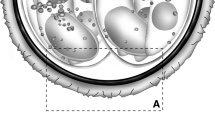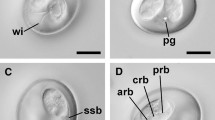Abstract
Columbiformes have a worldwide distribution, of which 166 species occur in Eurasia. They have been reported parasitized by coccidians recurrently in recent years; however, Eimeria labbeana (Labbé, 1896) Pinto, 1928, which is first Eimeria sp. from Columbiformes described in the late nineteenth century, is not taxonomically identified by its oocysts since the 1930s. In this context, the current study aimed to supplement the morphology of E. labbeana from Eurasian collared doves Streptopelia decaocto Frivaldszky, 1838 and from a common woodpigeon Columba palumbus Linnaeus, 1758 in Portugal, providing a preliminary genotypic characterization. Three of the four columbiforms were positive for oocysts identified as E. labbeana, which were morphologically revised as having micropyles, in addition to other minor adjustments. Oocysts from S. decaocto and C. palumbus were morphologically identical and equivalent in all morphometric aspects, besides having genotypic similarity of 99.5%. Phylogenetic analysis based on the mitochondrial cytochrome c oxidase subunit 1 gene resulted in a large clade with Eimeria spp. and Isospora spp. from different vertebrates and low similarity between Eimeria spp. from Columbiformes, whereas the phylogenetic analysis based on the small subunit ribosomal RNA gene resulted in well-supported monophyletic groups, including one with the coccidians of columbiform birds.




Similar content being viewed by others
References
Adriano EA, Thyssen PJ, Cordeiro NS (2000) Eimeria curvata n. sp. (Apicomplexa: Eimeriidae) in Columbina talpacoti and Scardafella squammata (Aves: Columbidae) from Brazil. Mem Inst Oswaldo Cruz 95:53–55
Adriano EA, Thyssen PJ, Cordeiro NS (2003) A new species of Eimeria from the eared dove Zenaida auriculata (Aves: Columbidae) in Brazil. Acta Protozool 42:71–73
Alyousif SM, Al–Shawa RY, Al–Asiri, SS, (2009) Eimeria livialis sp. n. (Apicomplexa: Eimeriidae) from the domestic pigeon, Columba livia domestica in Saudi Arabia. J Egypt Soc Parasitol 39:383–388
Ayres M, Ayres M, Ayres DL, Santos AAS (2007) BioStat aplicações estatísticas nas áreas de Ciências Biomédicas. Mamirauá: Belém. 380 pp
Ball SJ, Daszak P, Swinnerton KR, Jones CG, Snow KR (2012) A new species of Eimeria (Apicomplexa:Eimeriidae) from the endangered pink pigeon, Nesoenas mayeri (Prévost, 1843) Cheke, 2005 (Columbiformes) in Mauritius. Afr Zool 47:369–372
Bandyopadhyay PK, Bhakta JN, Shukla R (2006) A new Eimeria species (Protozoa: Apicomplexa: Sporozoea) from the blue rock pigeon Columba livia (Aves: Columbidae). Zoos Print J 21:2386–2387
Berto BP, Lopes CWG (2020) Coccidia of wild birds as ecological biomarkers: Some approaches on parasite-host-environment interaction. J Parasitol 106:707–713
Berto BP, McIntosh D, Lopes CWG (2014) Studies on coccidian oocysts (Apicomplexa: Eucoccidiorida). Rev Bras Parasitol Vet 23:1–15
Chatterjee DK, Ray HN (1969) On Eimeria kapotei n. sp., from the domestic pigeon, Columba livia intermedia. Proc 24th Indian Sci Cong 56:512
Coussement W, Maes L, Vanparijs O, Marsboom R (1988) Action of the anticoccidial clazuril on the endogenous stages of Eimeria labbeana and E. columbarum in experimentally infected pigeons. Res Vet Sci 45:117–119
Dolnik OV, Palinauskas V, Bensch S (2009) Individual oocysts of Isospora (Apicomplexa: Coccidia) parasites from avian feces: from photo to sequence. J Parasitol 95:169–174
Dolnik OV, Dolnik VR, Bairlein F (2010) The effect of host foraging ecology on the prevalence and intensity of coccidian infection in wild passerine birds. Ardea 98:97–103
Duncan S (1957) The effects of some chemical and physical agents on the oocysts of the pigeon coccidium, Eimeria labbeana (Pinto, 1928). J Parasitol 45:193–197
Duszynski D, Wilber P (1997) A guideline for the preparation of species descriptions in the Eimeridae. J Parasitol 83:333–336
Duszynski D, Couch, L, Upton SJ (2000) The coccidia of the world. Available from: https://www.k-state.edu/parasitology/worldcoccidia. Accessed 23 Apr 2020
Genovez-Oliveira JL, Oliveira MS, Thode-Filho S, Cardozo SV, Oliveira ÁA, Lima VM, Ferreira I, Berto BP (2020) Morphological and molecular identification of Isospora massardi Lopes, Berto, Luz, Galvão, Ferreira & Lopes, 2014 (Chromista: Miozoa: Eimeriidae) from thrushes Turdus spp. (Passeriformes: Turdidae) in South America. Parasitol Int 75:102040
Golemansky V (1976) Three new coccidian species (Coccidia: Eimeriidae) found in wild birds from Bulgaria. Acta Protozool 15:399–404
IUCN (2020) The IUCN red list of threatened species. Available from: http://www.iucnredlist.org. Accessed 23 Apr 2020
Jamriška J, Modrý D (2012) A new species of Eimeria Schneider, 1875 (Apicomplexa: Eimeriidae) from the common wood pigeon Columba palumbus Linnaeus, 1758 (Aves: Columbidae). Acta Protozool 51:329–333
Labbé A (1896) Recherches zoologiques, cytologiques et biologiques sur less coccidies. Arch Zool Exp Gen 24:517–654
Marzouk M, Abdel-Ghaffar F, Mosaad MN (1989) Effects of infection with Eimeria labbeana on some serum constituents and liver glycogen in the palm dove (Streptopelia senegalensis aegyptiaca). Parasitol Res 75:183–185
Matsubara R, Fukuda Y, Murakoshi F, Nomura O, Suzuki T, Tada C, Nakai Y (2017) Detection and molecular status of Isospora sp. from the domestic pigeon (Columba livia domestica). Parasitol Int 66:588–592
McQuistion TE (1991) Eimeria palumbi, a new coccidian parasite (Apicomplexa: Eimeriidae) from the Galapagos dove (Zenaida galapagoensis). Trans Am Microsc Soc 110:178–181
Mitra AN, Das-Gupta M (1937) On a species of Eimeria (Coccidia–Sporozoa) from the intestine of a pigeon, Columba intermedia. Proc 24th Indian Sci Cong 24:291
Nieschulz O (1935) Ueber Kokzidien der Haustauben. Zentralbl Bakteriol Mikrobiol Hyg 134:390–393
Oliveira MS, Genovez-Oliveira JL, Ortúzar-Ferreira CN, Maronezi C, Thode-Filho S, Cardozo SV, Oliveira ÁA, Lima VM, Berto BP (2020) Eimeria ferreirai n. sp. (Chromista: Miozoa: Eimeriidae) from doves Leptotila spp. (Columbiformes: Columbidae) from Brazil. Zootaxa 4821:148–160
Ortúzar-Ferreira CN, Oliveira MS, Genovez-Oliveira JL, Franco HA, Thode-Filho S, Cardozo SV, Oliveira ÁA, Lima VM, Ferreira I, Berto BP (2020) Coccidia of Columbiformes: a taxonomic review of its Eimeriidae species and Eimeria columbinae n. sp. from Columbina talpacoti (Temminck, 1809) from Brazil. Parasitol Res 119:267–281
Pinto C (1928) Synonymie de quelques especes du genre Eimeria (Eimeridia, Sporozoa). C R Seances Soc Biol 98:564–1565
Quevedo CL, Arcay-de-Peraza L (1980) Desarrollo de Eimeria labbeana (Labbe, 1896) Pinto, 1928, en la membrana corioalantoidea de embrion de pollo (MCA), bajo la accion de la ciclofosfamida. Acta Biol Ven 10:255–301
Ray DK (1952) On a new coccidium, Eimeria sphenocercae n. sp., from Sphenocercus sphenurus (Kokla Green pigeon). J Parasitol 38:546–547
Sampaio IBM (2002) Estatística aplicada à experimentação animal. FEP MVZ Editora: Belo Horizonte. 265pp
Sick H (1997) Ornitologia Brasileira. Nova Fronteira, Rio de Janeiro, p 862
Tamura K, Dudley J, Nei M, Kumar S (2007) MEGA4: molecular evolutionary genetics analysis (MEGA) software version 4.0. Mol Biol Evol 24:1596–1599
Varghese T (1978) Eimeria waiganiensis sp. n. from the greenwinged ground dove (Chalcophaps indica Linnaeus) and the magnificent ground pigeon (Otidiphaps nobilis gould) in Papua New Guinea. J Parasitol 64:312–314
Varghese T (1980) Coccidian parasites of birds of the avian order Columbiformes with a description of two new species of Eimeria. Parasitol 80:183–187
Vercruysse J (1990) Efficacy of toltrazuril and clazuril against experimental infections with Eimeria labbeana and E. columbarum in racing pigeons. Avian Dis 34:73–79
Williams RB, Thebo P, Marshall RN, Marshall JA (2010) Coccidian oöcysts as type–specimens: long–term storage in aqueous potassium dichromate solution preserves DNA. Syst Parasitol 76:69–76
Yabsley MJ, Bailey K, Adams HC (2015) A new species of Eimeria (Apicomplexa: Eimeriidae) from the mourning dove, Zenaida macroura (Columbiformes: Columbidae). Comp Parasitol 82:231–234
Yang R, Brice B, Elliot A, Ryan U (2015) Isospora serinuse n. sp. (Apicomplexa: Eimeriidae) from a domestic canary (Serinus canaria forma domestica) (Passeriformes: Fringillidae) in Western Australia. Exp Parasitol 159:59–66
Yang R, Brice B, Elloit A, Ryan U (2016) Morphological and molecular characterization of Eimeria labbeana–like (Apicomplexa:Eimeriidae) in a domestic pigeon (Columba livia domestica, Gmelin, 1789) in Australia. Exp Parasitol 166:124–130
Acknowledgements
We thank the staff at the Lisbon Center for Wild Animal Recovery, in Monsanto Forest Park, Lisbon, Portugal, who enabled the collection of samples from birds held for rehabilitation and reintroduction into the wild.
Funding
This study was supported by Conselho Nacional de Desenvolvimento Científico e Tecnológico (CNPq), Coordenação de Aperfeiçoamento de Pessoal de Nível Superior (CAPES), Fundação Carlos Chagas Filho de Amparo à Pesquisa do Estado do Rio de Janeiro (FAPERJ), and Centro de Investigação Interdisciplinar em Sanidade Animal (Project UIDP/CVT/00276/2020, funded by FCT). MSO have scholarship from CAPES (Grant/Award Number: 001). BPB has a fellowship from CNPq (Grant/Award Number: 303899/2019–0) and from FAPERJ (Grant/Award Number: E-26/202.797/2019). DWR has a postdoctoral fellowship from FCT (Grant/Award Number: SFRH/BPD/115202/2016).
Author information
Authors and Affiliations
Corresponding author
Ethics declarations
Ethics approval
All applicable institutional, national and international guidelines for the care and use of animals were followed. Animal manipulation in the Lisbon Center for Wild Animal Recovery was performed by suitably qualified professionals, according to the directive 86/609/EEC.
Conflict of interest
The authors declare no competing interests.
Additional information
Section Editor: Daniel K Howe
Publisher's note
Springer Nature remains neutral with regard to jurisdictional claims in published maps and institutional affiliations.
Rights and permissions
About this article
Cite this article
Oliveira, M.S., Ramilo, D.W., Mello, E.R. et al. Supplementary morphological data and molecular analyses of Eimeria labbeana (Labbé, 1896) Pinto, 1928 (Chromista: Miozoa: Eimeriidae) from columbiform birds in Portugal. Parasitol Res 120, 3569–3580 (2021). https://doi.org/10.1007/s00436-021-07300-x
Received:
Accepted:
Published:
Issue Date:
DOI: https://doi.org/10.1007/s00436-021-07300-x




